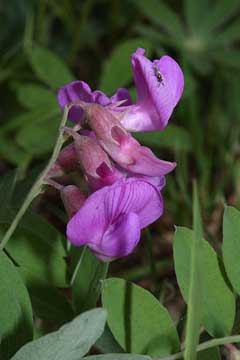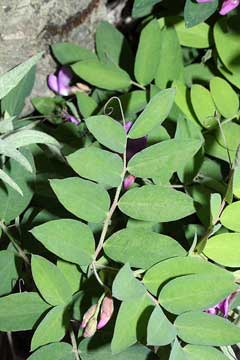 |
|
commons.wikimedia.org/wiki/User:Wsiegmund |
 |
| commons.wikimedia.org/wiki/User:Wsiegmund |
Translate this page:
Summary
Physical Characteristics

 Vicia americana is a PERENNIAL growing to 1 m (3ft 3in) by 1 m (3ft 3in).
Vicia americana is a PERENNIAL growing to 1 m (3ft 3in) by 1 m (3ft 3in).
See above for USDA hardiness. It is hardy to UK zone 5. It is in flower in July. The species is hermaphrodite (has both male and female organs) and is pollinated by Insects. The plant is self-fertile.
It can fix Nitrogen.
Suitable for: light (sandy), medium (loamy) and heavy (clay) soils and prefers well-drained soil. Suitable pH: mildly acid, neutral and basic (mildly alkaline) soils. It can grow in semi-shade (light woodland) or no shade. It prefers moist soil.
UK Hardiness Map
US Hardiness Map
Synonyms
Lathyrus diffusus. Orobus diffusus
Plant Habitats
Cultivated Beds;
Edible Uses
Edible Parts: Leaves Seed Seedpod Shoots
Edible Uses:
Young shoots - cooked[105, 155, 161]. The tender seeds are eaten by the N. American Indians[212]. Both the mature seeds and the immature seedpods can be used[257]. The pod is about 3cm long and contains 4 - 7 seeds[235].
References More on Edible Uses
Medicinal Uses
Plants For A Future can not take any responsibility for any adverse effects from the use of plants. Always seek advice from a professional before using a plant medicinally.
Ophthalmic Salve Stings
The leaves have been rubbed in the hands and applied to spider bites[257]. An infusion of the crushed leaves have been used as a bath for treating soreness[257]. An infusion of the plant has been used as an eyewash[257]. An infusion of the leaves has been used by women as a love medicine[257].
References More on Medicinal Uses
The Bookshop: Edible Plant Books
Our Latest books on Perennial Plants For Food Forests and Permaculture Gardens in paperback or digital formats.

Edible Tropical Plants
Food Forest Plants for Hotter Conditions: 250+ Plants For Tropical Food Forests & Permaculture Gardens.
More

Edible Temperate Plants
Plants for Your Food Forest: 500 Plants for Temperate Food Forests & Permaculture Gardens.
More

More Books
PFAF have eight books available in paperback and digital formats. Browse the shop for more information.
Shop Now
Other Uses
String
The stout roots have been used for tying[257]. A dynamic accumulator gathering minerals or nutrients from the soil and storing them in a more bioavailable form - used as fertilizer or to improve mulch. Nitrogen Fixer.
Special Uses
Dynamic accumulator Food Forest Nitrogen Fixer
References More on Other Uses
Cultivation details
We have very little information on this species and do not know if it will be hardy in Britain, though judging by its native range it should succeed outdoors in many parts of the country. The following notes are based on the general needs of the genus. Succeeds in any well-drained soil in a sunny position if the soil is reliably moist throughout the growing season, otherwise it is best grown in semi-shade[200]. A climbing plant, attaching itself to supports by means of tendrils[212]. This species has a symbiotic relationship with certain soil bacteria, these bacteria form nodules on the roots and fix atmospheric nitrogen. Some of this nitrogen is utilized by the growing plant but some can also be used by other plants growing nearby[200]. For polyculture design as well as the above-ground architecture (form - tree, shrub etc. and size shown above) information on the habit and root pattern is also useful and given here if available. Growth habit is a single or multiple shooting vine from a crown [1-2]. Herbaceous. The root pattern is rhizomatous with underground stems sending roots and shoots along their length [1-2].
References Carbon Farming Information and Carbon Sequestration Information
Temperature Converter
Type a value in the Celsius field to convert the value to Fahrenheit:
Fahrenheit:
The PFAF Bookshop
Plants For A Future have a number of books available in paperback and digital form. Book titles include Edible Plants, Edible Perennials, Edible Trees,Edible Shrubs, Woodland Gardening, and Temperate Food Forest Plants. Our new book is Food Forest Plants For Hotter Conditions (Tropical and Sub-Tropical).
Shop Now
Plant Propagation
Pre-soak the seed for 24 hours in warm water and then sow in situ in spring or autumn.
Other Names
If available other names are mentioned here
Native Plant Search
Search over 900 plants ideal for food forests and permaculture gardens. Filter to search native plants to your area. The plants selected are the plants in our book 'Plants For Your Food Forest: 500 Plants for Temperate Food Forests and Permaculture Gardens, as well as plants chosen for our forthcoming related books for Tropical/Hot Wet Climates and Mediterranean/Hot Dry Climates. Native Plant Search
Found In
Countries where the plant has been found are listed here if the information is available
Weed Potential
Right plant wrong place. We are currently updating this section.
Please note that a plant may be invasive in one area but may not in your area so it’s worth checking.
Conservation Status
IUCN Red List of Threatened Plants Status :

| Related Plants
|
| Latin Name | Common Name | Habit | Height | Hardiness | Growth | Soil | Shade | Moisture | Edible | Medicinal | Other |
| Artemisia ludoviciana | White Sage, Louisiana Sage, Prairie Sage, Western Mugwort | Perennial | 1.0 |
4-9
| M | LM | SN | DM | 2 | 2 | 2 |
| Artemisia ludoviciana gnaphalodes | White Sage | Perennial | 1.0 |
4-8
| | LM | SN | DM | 0 | 2 | 1 |
| Avena ludoviciana | Oats | Annual | 0.0 |
-
| | LMH | N | DM | 2 | 0 | 2 |
| Lactuca ludoviciana | Western Wild Lettuce, Biannual lettuce | Biennial | 1.2 |
0-0
| | LM | SN | M | 2 | 2 | |
| Orobanche ludoviciana | Broomrape, Louisiana broomrape | Perennial | 1.5 |
0-0
| | LMH | FSN | M | 1 | 1 | 0 |
| Vicia amoena | | Perennial | 1.0 |
-
| | LMH | SN | M | 1 | 0 | |
| Vicia amurensis | | Perennial | 1.5 |
-
| | LMH | SN | M | 1 | 0 | |
| Vicia articulata | One-Flower Vetch | Annual | 0.6 |
-
| | LMH | SN | M | 1 | 0 | 3 |
| Vicia benghalensis | Purple Vetch | Annual/Perennial | 0.6 |
-
| F | LMH | SN | M | 0 | 0 | 3 |
| Vicia caroliniana | Carolina vetch, Carolina wood vetch | Perennial | 0.6 |
3-9
| M | LMH | FSN | M | 0 | 2 | 4 |
| Vicia cracca | Tufted Vetch, Bird vetch, Cow vetch | Perennial Climber | 1.8 |
4-8
| | LMH | SN | M | 1 | 1 | 3 |
| Vicia ervilia | Bitter Vetch | Annual | 0.6 |
-
| | LMH | SN | M | 1 | 0 | |
| Vicia faba equina | Horsebean | Annual | 1.0 |
4-8
| F | LMH | SN | M | 3 | 0 | 3 |
| Vicia faba major | Broad Bean, Fava Bean | Annual | 1.0 |
4-10
| F | LMH | SN | M | 4 | 1 | 3 |
| Vicia faba minuta | Tick Bean | Annual | 1.0 |
4-8
| F | LMH | SN | M | 3 | 0 | 3 |
| Vicia gigantea | Giant Vetch | Perennial | 1.0 |
4-8
| | LMH | SN | M | 2 | 1 | 3 |
| Vicia grandiflora kitaibeliana | large yellow vetch | Annual | 0.0 |
-
| | LMH | SN | M | 2 | 0 | |
| Vicia heptajuga | | Perennial | 0.0 |
-
| | LMH | SN | M | 1 | 0 | |
| Vicia hirsuta | Hairy Tare, Tiny vetch | Annual | 0.5 |
4-9
| | LMH | SN | M | 2 | 0 | 3 |
| Vicia hirticalycina | | Perennial | 0.0 |
-
| | LMH | SN | M | 1 | 0 | |
| Vicia japonica | | Perennial | 1.5 |
-
| | LMH | SN | M | 1 | 0 | |
| Vicia monantha | Hard Vetch, Barn vetch | Annual | 0.0 |
0-0
| | LMH | SN | M | 2 | 0 | 3 |
| Vicia narbonensis | French Vetch, Purple broad vetch | Annual | 1.0 |
0-0
| | LMH | SN | M | 2 | 0 | |
| Vicia nipponica | | Perennial | 0.8 |
-
| | LMH | SN | M | 1 | 0 | |
| Vicia noeana | | Annual | 0.6 |
-
| | LMH | SN | M | 1 | 0 | |
| Vicia pisiformis | Pea Vetch, Pale-flower vetch | Perennial | 1.8 |
0-0
| | LMH | SN | M | 1 | 0 | |
| Vicia pseudo-orobus | | Perennial | 1.5 |
-
| | LMH | SN | DM | 1 | 0 | |
| Vicia sativa | Winter Tares, Garden vetch, Subterranean vetch | Annual Climber | 1.2 |
4-8
| F | LMH | SN | M | 3 | 0 | 3 |
| Vicia sativa leucosperma | Winter Tares | Annual Climber | 1.2 |
4-8
| F | LMH | SN | M | 3 | 0 | 3 |
|
|
Growth: S = slow M = medium F = fast. Soil: L = light (sandy) M = medium H = heavy (clay). pH: A = acid N = neutral B = basic (alkaline). Shade: F = full shade S = semi-shade N = no shade. Moisture: D = dry M = Moist We = wet Wa = water.

Expert comment
Author
Muhl.
Botanical References
43235
Links / References
For a list of references used on this page please go here
Readers comment